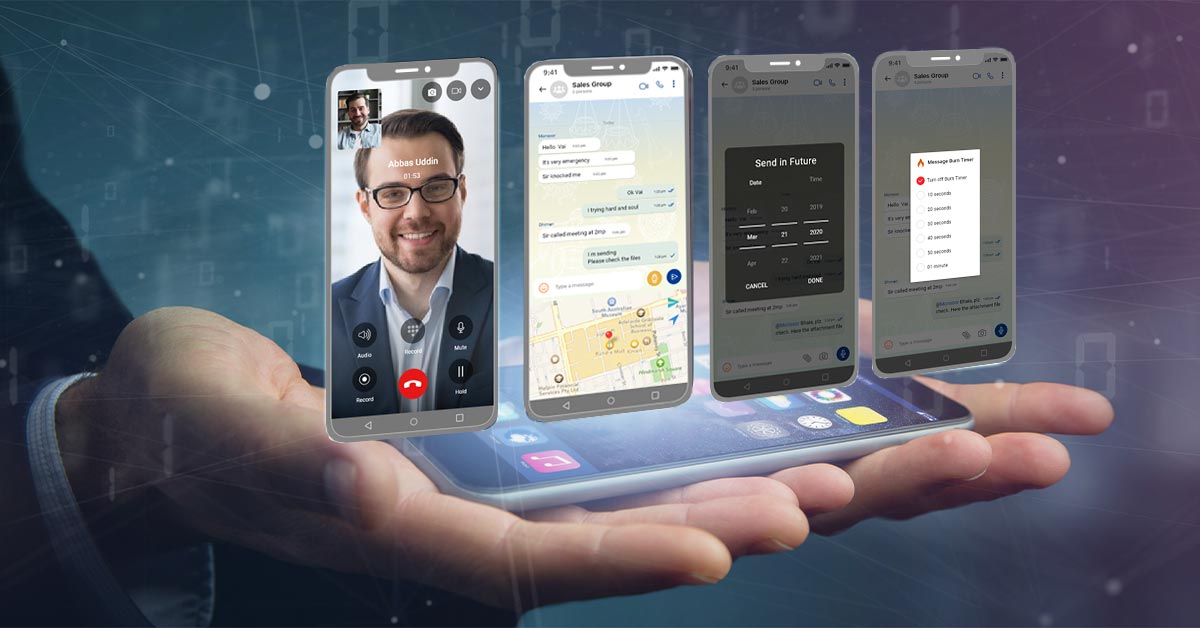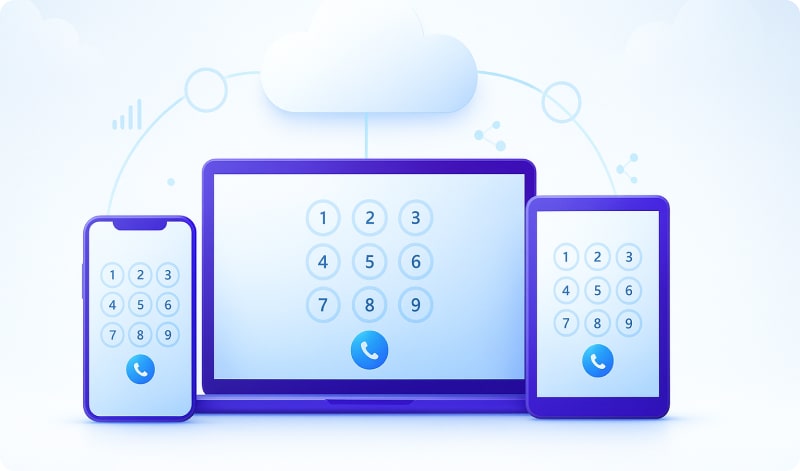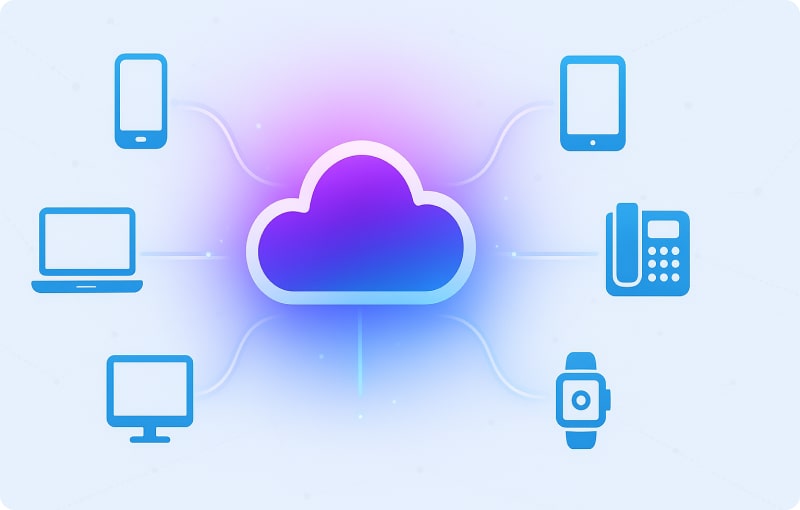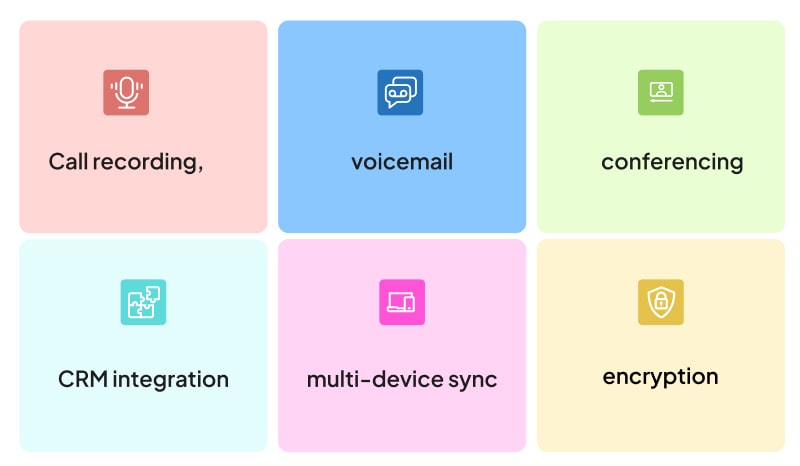
In today’s digital age, softphones have emerged as powerful communication tools, eliminating the need for traditional telephony systems. Revolutionizing how communication used to work, softphones are software applications that enable voice and video calling by leveraging VoIP technology. By using softphone applications, individuals and businesses can unleash new levels of productivity and flexibility.
Not just that, for Communication Service Providers (CSPs), ISPs, and VoIP operators, softphones bring a massive opportunity. With a white-label softphone or OTT communication app, providers can launch branded voice, video, and messaging services on their existing infrastructure, entering the fast-growing UCaaS market with minimal investment.
Let’s quickly dive into understanding – what is a softphone? How does it work? And why are businesses, from startups to global enterprises, adopting it.
What Is a Softphone?

Also called software phones, softphones are software-based applications through which users can make voice and video calls over the internet using Voice over Internet Protocol (VoIP) technology. Rather than those traditional telephone units, VoIP softphones transform a laptop, computer, smartphone, or tablet into a virtual phone unit, enabling communication and collaboration with others through various features such as voice, video, IM, etc.
In the simplest words, we can say that a softphone brings a business’s entire phone system into a single app – portable, cost-efficient, and scalable.
How Does a Softphone Work?

Softphones operate through VoIP (Voice over Internet Protocol) technology, where voice data is converted into packets and transmitted in digital format over IP (Internet Protocol) networks. Compared to traditional landlines, where fixed lines had to be installed or cellular service, softphones present a cost-friendly and convenient way to communicate, especially for long-distance or international calling.
Here’s how the process typically flows:
1. Login & Registration
The user logs into the softphone using SIP credentials provided by their VoIP provider.
2. SIP Signaling
When a call is made, the softphone uses the Session Initiation Protocol (SIP) to establish and manage the connection between the caller and the receiver.
3. Voice Transmission
Voice is encoded using codecs (like G.711 or G.729), converted into digital data packets, and sent over the internet.
4. Call Termination
On the other end, packets are decoded back into voice, resulting in a seamless audio experience.
Modern softphones also integrate with WebRTC and SBCs (Session Border Controllers) for enhanced quality, NAT traversal, and security.
Softphone vs. Traditional Desk Phone vs. VoIP
| Feature | Softphone | VoIP Desk Phone (IP Phone) | Traditional Desk Phone |
| Type | Software application | Hardware device (physical phone) | Hardware device (physical phone) |
| Technology Used | VoIP (Voice over Internet Protocol) | VoIP (Voice over Internet Protocol) |
PSTN (Public Switched Telephone Network – analog/digital lines)
|
| Connectivity | Internet connection (Wi-Fi, Mobile Data, Ethernet) | Internet connection (usually Ethernet cable) |
Dedicated copper phone line (PSTN)
|
| Hardware Required | Computer, smartphone, or tablet (with mic/speaker or headset) | Dedicated physical phone handset | Dedicated physical phone handset |
| Mobility | High – Useable anywhere with internet connection | Low – Fixed to a location (where the Ethernet port is) | Very Low – Fixed to a phone jack |
| Cost (Initial) | Low – Uses existing devices; only need software license | Medium to High – Requires purchasing physical hardware |
Medium to High – Requires dedicated lines, often a physical PBX system
|
| Call Quality | Variable – Highly dependent on the device’s mic/speaker/headset and internet speed | Generally High – Dedicated hardware and stable Ethernet connection |
Generally High – Reliable dedicated copper lines (can be susceptible to weather)
|
| Features | Extensive – Video calls, chat, CRM integration, voicemail, advanced call management | Moderate to High – HD Voice, multi-line support, conferencing |
Basic – Voice calls, voicemail, limited conferencing, caller ID
|
| Scalability | Very High – Easy and instant to add/remove users via software | High – Requires adding or removing physical devices |
Low – Requires physical line installation/modification
|
| Ideal For | Remote/hybrid workers, mobile staff, budget-conscious businesses, high feature needs | Fixed office staff, high-call-volume roles, preference for a dedicated device |
Very small offices or those in areas with poor internet connectivity
|
Types & Examples of Softphones

Softphones come in different types depending upon two factors: where they run (mobile, desktop, browser) and how they’re packaged (off-the-shelf vs white-label). Let’s understand this in more detail.
1. Mobile Softphones (iOS & Android apps)
These types of softphones are native smartphone apps that place and receive calls over IP using the device’s cellular data or Wi-Fi.
2. Desktop Softphones (Windows / macOS / Linux apps)
These softphones are installed applications for PCs/laptops that provide full-featured telephony. Such applications are commonly used in contact centers and knowledge-worker setups.
3. WebRTC Softphones (Browser-based)
These softphones run inside modern browsers using WebRTC, which means there’s no installation required for users. They work in Chrome, Edge, Firefox, and Safari.
4. White-Label Softphones (Custom-branded apps)
These softphones are ready-made softphone products rebranded and sometimes customized by Communication Service Providers (CSPs) or ITSPs for resale.
How to Use a Softphone?

Using a softphone is a convenient and cost-effective way to stay connected from anywhere. To enjoy the benefits of these software phones, you should know the steps to setting up and using a softphone, which are as follows:
1. Setting up the Softphone
The softphone that you have chosen has to be downloaded and installed on your device. You can visit the official website of your provider or contact them so that they will provide you with the application. After launching the softphone, you need to create your user account by providing the necessary information.
2. Account Customization
Once the setup is done, the next step is to set up your account settings. You may need additional details like your SIP server address and other credentials, which you can obtain from your service provider. This step also includes testing the connection, setting audio and microphone, adding contacts, etc.
3. Making Calls
Now that the softphone is set up, it is time to start making calls. For this, you can use the dial pad or just select the contact from within the softphone. For receiving calls, your softphone will provide you with different options such as answer, decline, etc.
4. Integration with CRM Systems
Integration with customer relationship management systems of softphones refers to the ability of the software phone application to connect and synchronize with a CRM system. While most of the softphones offer this facility, you can check with your vendor for the same.
5. Call Analytics
Many softphones offer analytics and reporting facilities, which are quite useful for a growing business. By having access to different call-related metrics and insights, businesses can optimize their call handling, customer service, and overall performance.
6. Virtual Phone Numbers
As the name suggests, these phone numbers are not tied to any physical location and can be used with the software-based phone application to make and receive calls using VoIP technology. These numbers come in various forms, such as DID numbers, Toll-free numbers, etc. There are also several features offered by virtual phone numbers, such as call routing, auto-attendant, call recording, voicemail, etc.
Softphones for Business: Why Enterprises Love Them
Using VoIP can lower the cost by 45% compared to traditional phones, increase productivity by 67%, improve voice quality, and save employers’ costs by enabling employees to work from home. Source
The usage of VoIP softphones is not only popular among individuals but also in business environments, especially in remote work scenarios. This is because of the useful benefits these software phones offer, as mentioned below:
Cost Savings
Softphones run and operate using VoIP technology, which provides a very pocket-friendly medium to make calls as it significantly reduces the cost of those high calling charges, especially for long-distance calls. Compared to traditional telephony, international calls using softphone apps can be made at much lower costs.
Mobility
Communication through a softphone app is not restricted to any physical location since there are no physical phone lines. Users can connect with the software phone app through any device that is connected to the internet. This is very helpful for remote workers or those who travel a lot in getting things done through seamless communication.
Flexibility
Softphones are capable of accommodating the changing needs of businesses. Without making any significant changes to the software, a business can add or remove users based on their current requirements.
Scalability
With softphones, scaling is as simple as assigning or revoking a license. New users can be added in minutes, which is ideal for growing teams or seasonal workforce fluctuations. It’s a communication setup that grows with the business, not one that limits it.
Custom Branding
For Communication Service Providers (CSPs) or Internet Telephony Service Providers (ITSPs), softphones offer an exceptional opportunity to launch branded communication apps. Providers can deploy white-label softphones, complete with custom logos, colors, and UI under their brand name.
Customers perceive the app as a proprietary solution, while the CSP retains full backend control. CSPs can monetize the service through monthly plans, calling bundles, or enterprise subscriptions.
Reliable Communication
Security is non-negotiable in business communication. Modern softphones employ advanced encryption and authentication mechanisms such as SIP over TLS for encrypted signaling, SRTP for secure voice and video streams, Two-factor authentication, and secure provisioning to prevent unauthorized use, and centralized monitoring and session border controllers (SBCs) for traffic control and threat prevention. This helps in gaining peace of mind knowing every call, message, and connection is protected against eavesdropping or tampering.
Key Features to Look For in a Business Softphone

Softphones come with a wide range of features and functionalities to provide communication facilities and enhance the experience. When selecting a business-grade softphone or launching a white-label version, look for:
VoIP Calling
It is the primary feature of software-based phones that enables users to make and receive voice calls over the internet. Softphones ensure crystal-clear voice quality by supporting various audio codecs.
Video Conferencing
Video calling is another key feature offered by softphones. Users can have audio and video interactions with one another in real-time using the internet. Not only for personal use, but video calling is also becoming quite popular among professionals. Video conferencing, wherein multiple group members can interact with each other, is quite useful in conducting virtual corporate meetings.
Instant Messaging
It is the feature that allows users to interact with each other by sending and receiving text-based messages in real time. This functionality facilitates quick communication and is similar to traditional instant messaging platforms being integrated into a softphone.
Media Sharing
Sharing visual content is quite a popular form of communication these days, and softphones facilitate this option through media sharing. Software phone app users can share different types of media, such as documents, presentations, images, videos, etc., within a conversation.
Location Sharing & Tracking
Softphones also incorporate GPS or location-based functionalities, thus providing the feature of Location sharing and tracking. Through this feature, the software phone app users can share their real-time location with others and can also track the movements of their friends, family, and other contacts. This is quite useful in address tracking when one wants to reach a person’s physical address.
Web Messaging
Softphones also offer the flexibility to use any internet-enabled device for calling, chatting, media sharing, and more. This means that not only through the software phone app, but users can also communicate and collaborate using the web-based interface from a computer, rather than installing a specific software application.
Conclusion
For Communication Service Providers, softphones represent a fast, cost-effective way to launch branded VoIP and OTT services, tap into the UCaaS market, and retain customers with modern mobility-driven communication tools.
By offering a white-label softphone, CSPs can transform from just bandwidth providers to complete communication service enablers, all while leveraging their existing VoIP infrastructure.
REVE Voice, Video, and Messaging App is a customized and white label SIP Softphone solution that allows Communication Service Providers to create their own VoIP-based branded mobile OTT app and launch service on the existing network. With REVE, service providers can launch or upgrade their OTT Communication Services with Instant Messaging (IM), Media Sharing, Audio-Video Calling, Mobile Recharges, and many more value-added features. For expert consultation, avail a free demo!
FAQs: What is a Softphone?
Is a softphone the same as VoIP?
VoIP is the technology; a softphone is the tool that uses VoIP to make calls.
Can softphones replace desk phones?
Absolutely. They provide all calling features without the hardware costs.
Do softphones support messaging?
Yes, many include chat, file sharing, and presence features.
How can CSPs benefit from launching softphones?
They can expand offerings, boost revenue, and retain customers via branded OTT services.
Are softphones suitable for call centers?
Yes, especially cloud-hosted ones integrated with CRM and reporting systems.






















